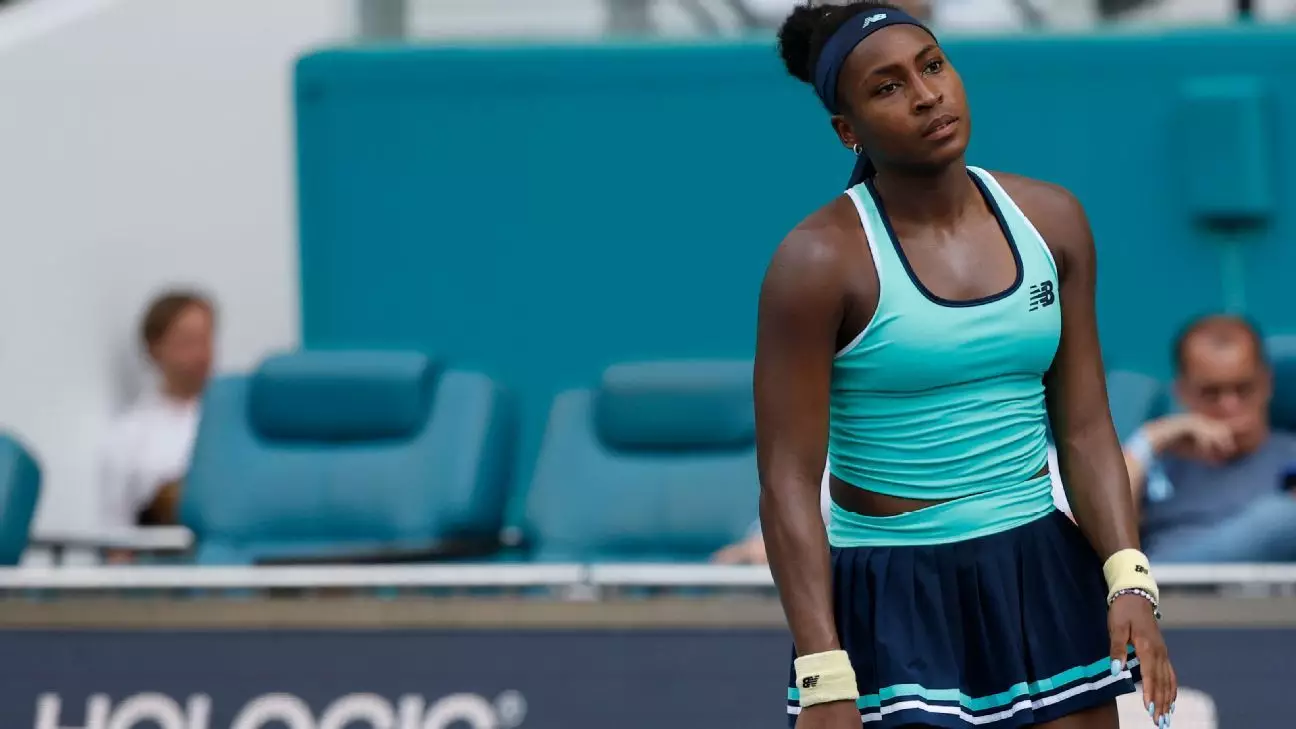The Miami Open witnessed a surprising upset on Monday when No. 3 seed Coco Gauff fell to unseeded Magda Linette in a straight-set loss, 6-4, 6-4. Fans had high hopes for Gauff, a promising star in American tennis, but her struggle with form was palpable. Committing a staggering 12 double-faults, the young player revealed cracks in her once-steady serve. With only half of her first serves making it into play and a string of unforced errors, Gauff’s performance was far from her best, raising questions about her mental fortitude during crucial matches.
The South Florida crowd attempted to rally behind Gauff as she managed to clinch a 4-3 lead in the second set. However, Linette, who has proven herself to be a formidable opponent even outside the seed ranks, remained composed, ultimately sealing the victory. Linette’s triumph marked a significant moment, as she hadn’t defeated a top-three player since 2021, stating, “It was really important for me to keep pressing Coco’s serve to make sure she feels the pressure.” This match encapsulates the unpredictable nature of sports, laying a foundation for discussions about Gauff’s need to develop strategies for overcoming pressure in high-stakes situations.
The Downfall of the American Contingent
Gauff was not alone in her disappointing exit. The day marked a tough one for American women’s tennis as defending champion Danielle Collins, alongside Amanda Anisimova and Ashlyn Krueger, also succumbed to defeat in straight sets. Collins, in particular, faced a challenging match against top seed Aryna Sabalenka, who showcased her prowess with an impressive display of 23 winners and seven aces. The clear disparity in performance drew a stark line between the remaining top players and the American contingent struggling to keep pace.
Sabalenka’s dominance reinforces her position as world No. 1, sending a clear message to her competitors: she is a force to be reckoned with. It raises an important conversation about the current climate of women’s tennis in the U.S. The losses indicate not just individual struggles but also the pressure placed on American players in the wake of a dwindling presence in the higher echelons of the sport.
Emerging Stars and Fierce Rivalries
On the flip side, some emerging stars are stepping onto the grand stage and asserting themselves. Although ranked lower, players like Linette and Italy’s Jasmine Paolini continue to defy expectations, paving pathways for their careers. Paolini’s victory over Naomi Osaka, who remains a formidable presence, proves that the game’s landscape is shifting. These younger players are not merely filling gaps but are actually becoming significant threats, suggesting a possible evolution in power dynamics within women’s tennis.
Adding to the excitement, Iga Swiatek, former Miami Open champion and current world No. 2, secured a place in the next round against Elina Svitolina in a nail-biting match that went into a tiebreak. Swiatek’s ability to maintain focus despite the tension serves as a notable contrast to Gauff’s challenges. Every close encounter further stirs anticipation within the tournament, hinting that experience is becoming just as essential as skills on the court.
A Beacon of Hope: Jessica Pegula
Among the American players, Jessica Pegula remains a beacon of hope following her decisive victory over Ukraine’s Marta Kostyuk. In a stunning show of resilience, Pegula won the final six games of the match, securing a 6-2, 6-3 win. Her next challenge will be against Emma Raducanu, the former US Open champion. Pegula’s commitment to elevating her game in these high-stake moments demonstrates a positive trajectory not just for her, but potentially for American tennis as a whole.
The matchup with Raducanu holds particular significance; both players are formidable, and their competitive histories add extra layers of intrigue. Raducanu herself described her upcoming challenge as daunting yet manageable. This spirit of competition embodies an essential aspect of sports—understanding the value of fierce rivalry while also recognizing the need for improvement and growth.
The Miami Open has unfolded like a tapestry of victories, defeats, and rising hopes, reminding us that while the day belongs to some, it can simultaneously serve as a ground for learning and growth for others. The resilience shown by players amidst enormous pressure underscores the intricacies and unpredictable nature of the sport. As the tournament progresses, it promises to provide even more thrilling moments and revelations, fueling the lifelong love affair between tennis and its fans.

